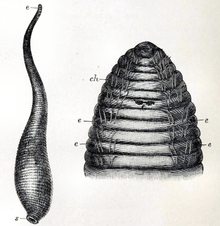Acanthobdella peledina
Acanthobdella peledina is a species of leech in the infraclass Acanthobdellidea. It feeds on the skin and blood of freshwater fishes in the boreal regions of northern Europe, Asia and North America.[2]
| Acanthobdella peledina | |
|---|---|
 | |
| Acanthobdella peledina | |
| Scientific classification | |
| Kingdom: | Animalia |
| Phylum: | Annelida |
| Class: | Clitellata |
| Order: | Acanthobdellida |
| Family: | Acanthobdellidae |
| Genus: | Acanthobdella |
| Species: | A. peledina |
| Binomial name | |
| Acanthobdella peledina Grube, 1851[1] | |
Taxonomy
Leeches in this infraclass are primitive, and some authors place them in a separate subclass to the Hirudinea.[3] However, the World Register of Marine Species places them within the Hirudinea, as a sister group to Euhirudinea, the true leeches.[4] Acanthobdella peledina was first described by the German zoologist Adolph Eduard Grube in 1851.[1] For a long time, it was believed to be the only species in the infraclass, but in 1966, another species in the genus, A. livanowi, was described from the vicinity of the Kamchatka Peninsula in eastern Siberia.[5]
Description
A. peledina differs from other fish leeches in not having a sucker at its anterior end; instead, it attaches to its host with about forty hooked chaetae (chitinous bristles) borne on its first five segments.[6] It is in fact unique among leeches in having chaetae at all, and also in having a coelom (body cavity) divided by septa into a discontinuous channel.[6] Other ways in which it differs from other leeches are that the body is divided into 29 segments, it lacks a prostomium and a peristomium, and the nephridia do not have funnels. It has a sucker at the posterior end, and moves in a typical leech fashion by alternately extending its anterior end forward, then clinging on with its hooked chaetae while it brings its posterior sucker close to its front end.[6] The leeches are cylindrical, olive green and about 23 mm (0.9 in) in length.[7]
Distribution
The species has a boreal distribution and is known from freshwater locations in northern Europe and Asia, and from Alaska.[6]
Ecology
One of the fish in Alaska parasitized by A. peledina is the sardine cisco (Coregonus sardinella). The leeches were found just behind the pelvic fins with their anterior ends embedded in the skin and muscle tissue below.[7]
References
- Kolb, Jürgen (2018). "Acanthobdella peledina Grube, 1851". WoRMS. World Register of Marine Species. Retrieved 7 May 2018.
- Ax, Peter. "Acanthobdella peledina — Autobdella". Multicellular Animals: 69–71. doi:10.1007/978-3-662-10396-8_17.
- Siddall, Mark E.; Burreson, Eugene M. (1996). "Leeches (Oligochaeta?: Euhirudinea), their phylogeny and the evolution of life-history strategies". Hydrobiologia. 334 (1–3): 277–285. doi:10.1007/bf00017378.
- Kolb, Jürgen (2018). "Hirudinea". WoRMS. World Register of Marine Species. Retrieved 7 May 2018.
- Kolb, Jürgen (2018). "Acanthobdella livanowi (Epshtein, 1966)". WoRMS. World Register of Marine Species. Retrieved 7 May 2018.
- Ruppert, Edward E.; Fox, Richard, S.; Barnes, Robert D. (2004). Invertebrate Zoology, 7th edition. Cengage Learning. pp. 478–482. ISBN 978-81-315-0104-7.
- Hauck, A.K.; Fallon, Michael J.; Burger, Carl V. (1979). "New host and geographical records for the leech Acanthobdella peledina Grube 1851 (Hirudinea, Acanthobdellidae)". Journal of Parasitology. 65 (6): 989. doi:10.2307/3280268.